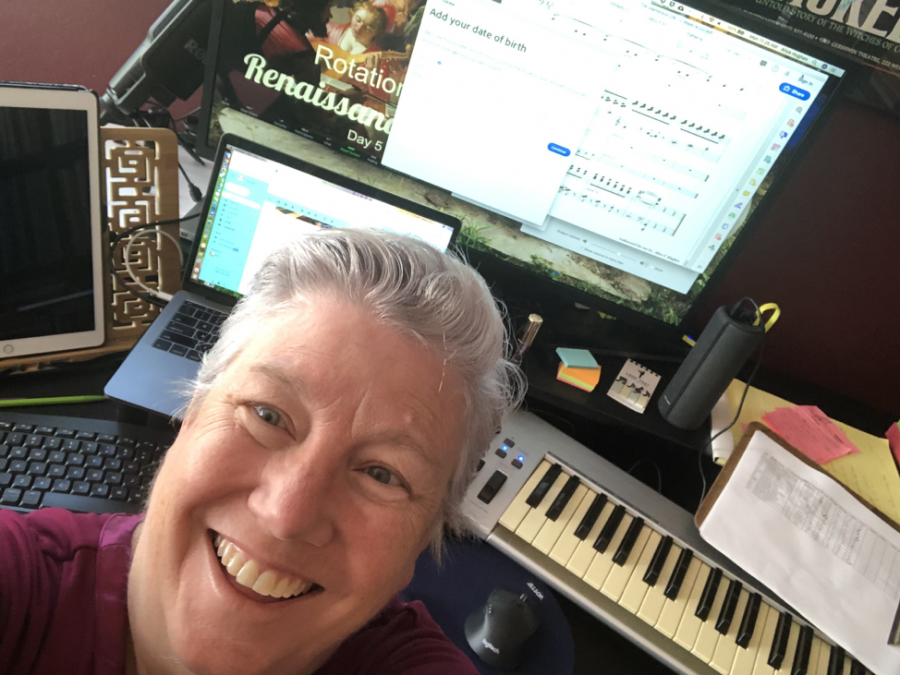Zoom Choir Class at PCS Adapts to Distance-Learning Difficulties
Students Sing Apart. . . Together!
November 3, 2020
Have you ever tried singing happy birthday to someone over a Zoom call, with multiple people singing at once? While possibly endearing, it’s a completely incoherent cacophony. This presents an even greater issue to ensemble music classes like choir, where making live music “ensemble” (“together” in French) is the fundamental concept of the class. A few weeks ago, I talked to Ms. Hughes, director of PCS’ men’s and women’s choirs (Canto Basso and Bella Voce respectively) and teacher of 7th grade performing arts, for a glimpse into what a group singing class is like on Zoom.
Thematic Schematic
Last school year, students and teachers were quite suddenly thrown into distance learning. Comparing her previous, improvised class plan to this year’s schematic, Ms. Hughes laughs: “There [are] only a couple of things that are the same – most everything else is different.” This year, each rotation is based on a main theme. For example, the theme of the last rotation was Songs of Protest, centered around how music was used in revolutions and protests. The songs and music history the students learn are then based off of that theme.
Singing from Home
Choir is an ideal class for people who like to sing, but are hesitant to do so in front of others. In a choir, they’re part of a larger voice of numerous other people. Unfortunately, simultaneous group singing isn’t technically possible during a Zoom call. This is largely due to latency, or the time between when someone makes a sound on one end of the call and when you hear it on your end. It makes singing in time with each other impossible. So in virtual classes, one of the greatest challenges is getting students comfortable with recording their voices on their own, in a space where other household members might be able to hear them. Ms. Hughes has found this discomfort especially prominent with students who are new to PCS. “They don’t know me from an atom, and I’m making them do all these things, and that’s hard.”
To help quickly familiarize the students with individual singing, she makes daily sung assignments a large part of the grade. She has also emailed parents with tips and instructions on how to save their students some stress over singing at home. These include a zero-comments rule and providing them with a private space, if possible. Finally, Ms. Hughes encouraged students who did feel comfortable to share some tips with the class. One person suggests that they simply pretend nobody else is in the house.
Check out these recordings of Ms. Hughes’ choir classes!
Is it choir?
All this fuss over individual singing begs the question, is it even choir? To determine that, we first need a good definition of “choir”. According to Ms. Hughes, “choir is the quintessential group activity. Choir requires listening, choir requires… being in tune with your fellow singers.” And more importantly, “choir makes all of us more than the sum of who we are… When we’re in a room singing together, the beauty that we create is more than just the people in the room. And you can’t do that this way.” So no, it’s not really choir. “I’m teaching vocal technique and musicianship,” she clarifies. “I know that [‘choir’ is] what the classes are called, but that’s not what I’m teaching.”
It’s not to say that students aren’t getting much out of the class this year. “I do believe that kids are going to… come out a little more independent in their musicianship, because they are being forced to be so,” Ms. Hughes says. There are also other small perks of being on Zoom, though none come close to outweighing the loss of in-person singing. For example, in late September, the men’s choir had a professional in Byzantine chant, who currently resides in Greece, be a guest speaker for their Medieval Music rotation.
On-Site Classes
If PCS transitions to on-campus teaching, choir classes would have to be held outdoors (because the best singers are the ones that can exhale the longest and strongest). The biggest worry with hosting any class outdoors is the weather. If it rains, or even if it’s just really really cold this winter, the class cannot be outside. Initially, the hope was that choir could be held in the student center – one of the only spaces on campus big enough to host the roughly fourteen-singer classes. But two of those classes are 3rd and 4th period, which means the student center would be hosting lunch preparations.
Currently, Ms. Hughes plans for students to stand (outside) 10-14 feet apart, fully masked. She herself would wear a face mask and some kind of extra guard, given that she’d be standing in front of all the actively exhaling students to conduct. She also plans to have a microphone of some sort, to save herself the strain of yelling to her already socially distant class.
The Small Joys
Seemingly, the only thing we know definitively about the future of pandemic-era choir class is that it’s very indefinite. Throughout the PCS community, and throughout the world, COVID-19 has likewise caused a significant amount of uncertainty. For the sake of our sanity, it’s even more important now to be able to find small moments of joy in our day-to-day lives. Ms. Hughes recalls one such moment from the first few weeks of class: She had taken recordings of the women’s choir singing a major scale, and edited the audio together. The do, re, mi, fa, thing, “not talking great music here” she chuckles. “And when I played the recording for the ladies, it was so sweet to watch their faces… When the harmony started… the look on their faces was just so much joy, and it was so nice to see that joy… because they hadn’t heard themselves… and that was really special.”


